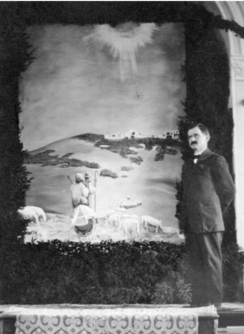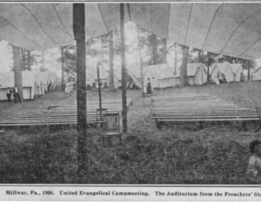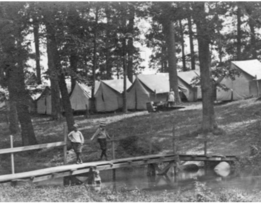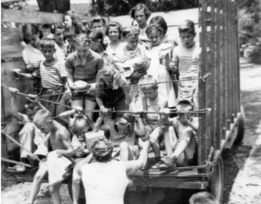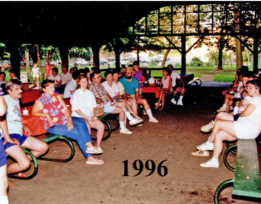This is the first in a series of twelve articles which will address a variety of subjects relating to Lititz Trinity’s 150 years of history and its service to God.
The first subject to be addressed will be the reason for the change from 2021 to 2022 for the Church’s 150th anniversary celebration. This question has been posed by several members of the congregation.
First it should be pointed out that for the first 97 years of the Church’s existence its anniversaries were celebrated based on the founding date of 1872.
For example, in 1922, from Sunday, June 25 through Sunday, July 2, Trinity (then Trinity United Evangelical), celebrated its 50th anniversary with a week-long program of services. The church sanctuary was elaborately decorated for the occasion (see photograph). Within the arch above the pulpit area was the “50th” in large gold lettering surrounded by an oval frame ornamented with bows and having a background of crepe paper streamers. Below the “50th” hung a large banner containing the word “Jubilee” in gold lettering. While on either wall flanking the pulpit were the dates “1872” and “1922”.
The Church’s 75th Anniversary was celebrated in 1947 with a series of week-long activities beginning May 18 and continuing through May 25.
Then 5 years later, on Sunday, May 18, 1952, the Church observed the 80th anniversary of its founding. For all of these anniversaries there were still members of the congregation living who would've been able to recall the sequence of the Church’s founding. Traditionally the last of the congregation’s “charter members” was Nancy (Weaver) Gingrich who was born in 1860 and lived until 1953 and witnessed all of Trinity’s long history.
Following the 80th anniversary the Church continued to annually celebrate its founding through 1969, the church’s 97th anniversary. Then in 1970 the Official Board voted to change the founding date to 1871, skip the 98th anniversary, celebrate the 99th anniversary in 1970, and the 100th in 1971. How exactly did this change come about? During the February 10, 1970 meeting of the Official Board, Raymond S. Reedy submitted a recommendation regarding the Church’s 100th Anniversary. He stated that “all information indicated the establishment of the church in 1871.” Then, on behalf of the Anniversary Committee, he recommended that the 100th anniversary be celebrated in September of 1971. The recommendation was approved. The board minutes do not provide any documentation or further explanation relating to the “information” establishing 1871 as the new founding date.
The 100th Anniversary booklet published in 1971 reads: “In the month of July, 1871, Rev. A. Shultz, preacher in charge of the Brownstown Circuit, came to Lititz, and held prayer meetings in the home of George Shaffner, on Pine Alley, but could not establish a work.” Both ministers mentioned, Rev. Jacob Newcomer Metzger (1824-1911) and the Rev. Francis P. Lehr (1828-1900), were at one time pastors of the Evangelical Association’s Church on Mulberry Street in Lancaster. Metzger served the Lancaster congregation from 1867 to March of 1870 when he was reassigned to the Dauphin Circuit. He was replaced by Lehr who served both the Water Street and Mulberry Street Churches in Lancaster until he was reassigned in February 1873. So it appears their attempts to establish an Evangelical mission in Lititz between 1870 and 1871 were unsuccessful. Though certainly the Pine Lane house was used for preaching purposes. No documentation could be found to support it being the home of the George Shaffner family. According to the U.S. Census in 1870, the Shaffner family lived in Rothsville and by 1880 they had moved to Lititz and resided at 47 East Main Street.
Interestingly two large leather bound “Record” books, both published by the Evangelical Association in 1872, survive in our Church’s archives. The books are identical except for the manuscript entries contained in them. Both books contain a number of pages at the front of the book where the ministers could record the church’s “Historical Record.” In the first book, the “Historical Record” form “1871” through 1879 was written by a single, unidentified hand, possibly that of Rev. Oplinger (served 1876-1879), the church’s fourth pastor. No entries were made from 1880 until 1887 when yet another unidentified hand, possibly that of Rev. Dilabar (served 1885-1888), the church’s seventh pastor, added several small paragraphs. The record concluded with a single entry written, signed, and dated February 7, 1889, by Rev. Warfel (1888-1891), the church’s eighth pastor.
In the second volume the church’s early history was rewritten by Rev. Warfel probably in 1889-1890. The date of the church’s founding was corrected from 1871 to 1872 and the conference date when the Rev. Shultz (served 1872), the first pastor, was replaced by Rev. Dreibelbis (served 1873-74), the second pastor, was corrected from 1872 to 1873. A manuscript notation on page 90 of the “Record of Members” in the second volume reads: “The former Record [referring to the first volume] was so imperfectly kept by the pastors, that it was a necesity [sic] to get this one and start new…”
In regard to Rev. Abraham Schultz, who all sources agree was Trinity’s first pastor, he wasn’t assigned to the Brownstown Circuit (which Lititz would’ve been part of) until March of 1872 during the meeting of the Annual Conference held in Pine Grove, PA. His appointment is documented by a newspaper article in the March 9, 1872 issue of Lancaster’s “Intelligencer Journal.” The following year, in March of 1873, Rev. Shultz was reassigned by the Conference to the Lancaster Circuit and Rev. Reuben Dreibelbis was assigned to the Brownstown Circuit.
So for the 150th Anniversary it was decided to return to celebrating the documented founding date of 1872 which had previously been observed for the first ninety-seven years of Lititz Trinity’s existence.




